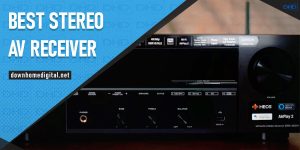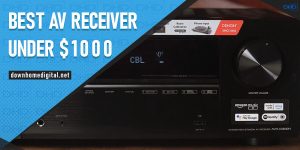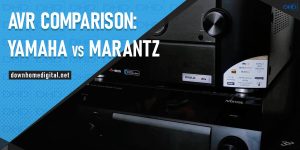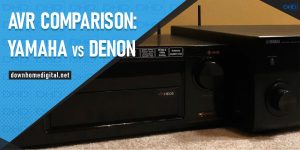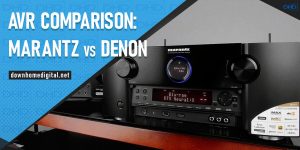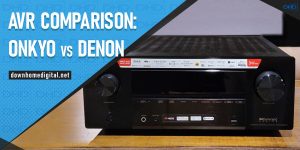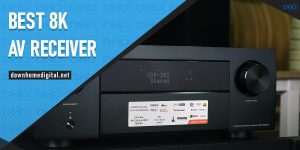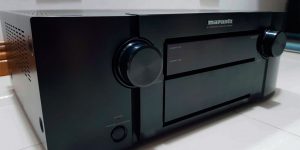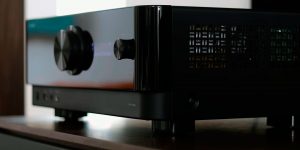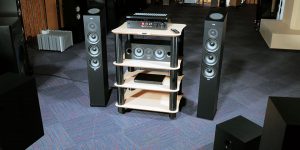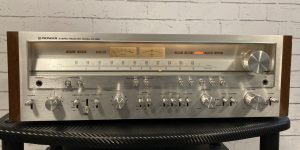Many audiophiles go crazy for the models created by this brand, as all of them are awesome. No wonder the Onkyo receivers have incredibly high quality and can provide a mind-blowing sound. I analyzed a lot of different devices to find the best Onkyo receiver.
The company’s history began in 1946 in the Japanese city of Osaka. The first name of the company was Osaka Denki Onkyo K.K. During the 1970s, Onkyo amplifiers were hugely acclaimed by the international press. In the 1980s, Onkyo shone again with its cassette decks, M-series amplifiers, exceptional turntables, and tuners that were long the benchmarks in radio reception (Onkyo 4040 and Onkyo 8080 models).
And already in the 1990s, the company was one of the first to enter the then still emerging home theater market. Thanks to its own developments, which are still in use today, Onkyo has firmly established itself in this segment. Users quickly appreciated the high quality of the products, which allowed the company to become one of the leading brands in this area.
The peculiarity of Onkyo home theater systems is to offer high power, thanks to the house WRAT technology (Wide Range Amplifier Technology). The company also employed high-end video processors and was the first manufacturer in 2012 to equip its models with 4K scalers. Finally, Onkyo often integrates the processors for calibration and real-time management of dynamic range and equalization (AccuEQ Advance and AccuReflex). Series of home theater receivers systematically numbered 300, 400, 500, 600, 700, 800, 1000, 3000, and 5000, so that every user can find a device suitable for their budget and functionality. Also, note that the products of this company are designed for a wide budget and have different models, including Onkyo flagships receivers.
Now the company still has its headquarters in Osaka and still implements innovative features in its products. If you want to get a unit that will work smoothly for many years, let me show a few decent ones in this best Onkyo AV receivers review!
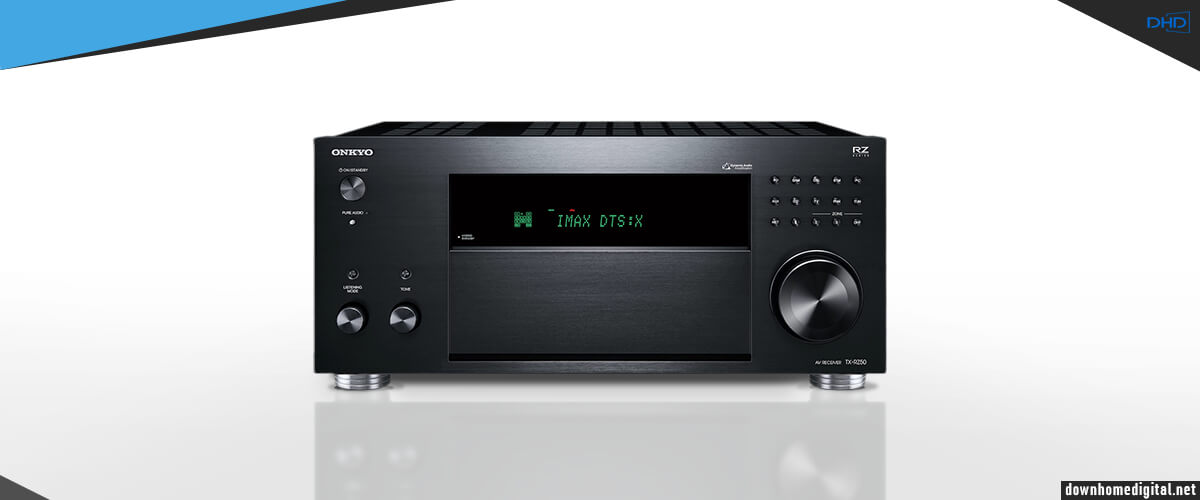
Onkyo AV receivers comparison table
| Name | Channels | Power output | HDMI in/out | Bluetooth/Wi-Fi | Review |
|---|---|---|---|---|---|
| Onkyo TX-RZ50 best overall | 9.2 | 120W/8 Ohm | 7/2 | yes/yes | Review |
| Onkyo TX-SR494 budget | 7.2 | 80W/6 Ohm | 4/1 | yes/no | Review |
| Onkyo TX-NR6100 also a great choice | 7.2 | 100W/6 Ohm | 6/2 | yes/yes | Review |
Best Onkyo receiver reviews
Onkyo TX-RZ50 – best overall

The first place in the rating is rightfully occupied by a wonderful representative of 9-channel receivers, the model 2021, Onkyo TX-RZ50. It is the most expensive, but it has an incredibly pleasant price in the market of receivers identical in functionality. This is because the manufacturer’s main focus is aimed at the consumer’s needs in the field of modernity and reliability. Still, Onkyo uses no special, unique internal components or technologies. Therefore, even the possibility of expanding the system with an additional stereo amplifier of up to 11 channels and maximum video and surround sound capabilities does not make the model in question premium. But it’s only to our advantage.
Onkyo’s models are like the Tin Woodman from the famous fairy tale, but after meeting the Wizard of Oz. The TX-RZ50 is simple in appearance but cute, reliable, massive, and pretty unremarkable, but the brand made sure it has a heart. I love its chrome legs and the huge LCD that shows everything you make your device do. The control buttons are made qualitatively, but I think they are too small. I’d say remote control solves the problem, but the model has a simple remote.
As I said, this is the most powerful receiver of the selection. It provides 120 watts (8 ohms, 20 Hz – 20 kHz, 0.08% THD, 2 ch), and they are real, as the distortion factor allows you to squeeze out the maximum volume without the risk of getting “dirt” and extraneous noise. To be fair, it should be noted that there is a similar receiver, TX-RZ840, in my selection. Still, it is in the category of obsolete models discontinued from production, so we will not emphasize it.
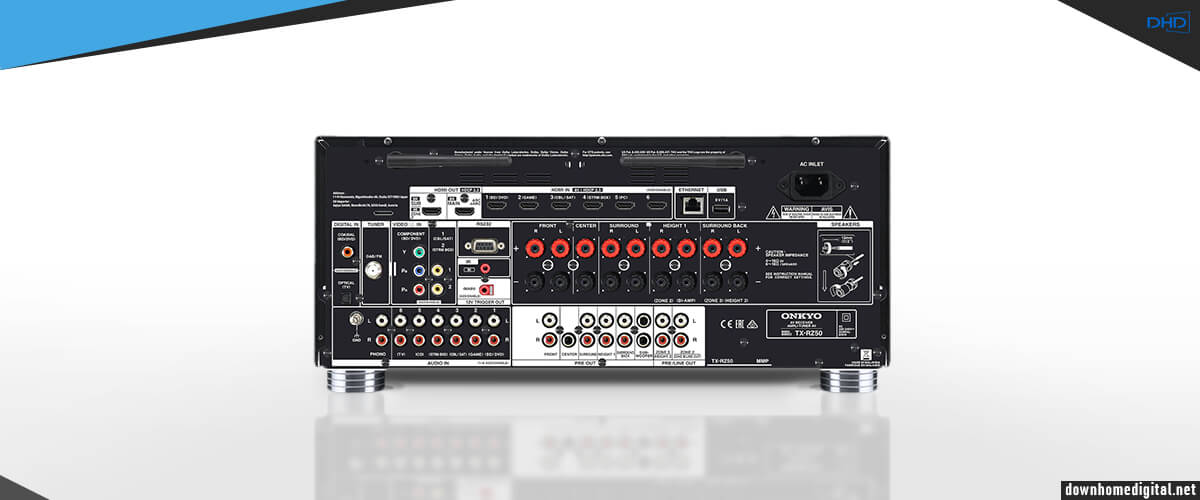
The video output is amazing. We have 7/2 HDMI ports, all version 2.1, support 8K video, upscaling to 8K, and all associated “goodies”. I enjoyed the highest-resolution transmission with this receiver, and the quality improvement isn’t too much of a letdown, either. There are some minor flaws, but they didn’t disappoint me too much. Playing on the console with the TX-RZ50 is a pleasure. Only another Onkyo model, TX-NR100, has such data, which would be the leader under other circumstances, as it loses to the model under consideration in other parameters. By the way, the TX-RZ840 does not have 8K video, only 4K.
If you dream of spending evenings apart from your kids, TX-RZ50 will solve this problem by providing 4K video broadcasting to the second zone. Audio from various sources can be streamed to 3 zones so that you can have separate parties.
The receiver has advanced wireless support functionality. I mean you can stream music with DTS Play-Fi or connect a Sonos system (but you have to buy a special port). The receiver has a lot of built-in streaming services, and Bluetooth supports AAC and aptX HD codecs. All in all, you don’t have to worry about whether your smartphone will fit; the AVR is perfectly compatible with Android or Apple. Unfortunately, you’ll have to buy a separate device to control the voice assistants. But Onkyo has a good, free app for both operating systems.
The surround sound of the receiver is beautiful. In Dolby Atmos and DTS:X in IMAX Enhanced mode, I got a fully immersive and revealing nuanced soundtrack of the Deadpool movie. Since the receiver has the highest rating of THX Certified Select, needless to say, Ryan Reynolds’ consummate humor amid explosions, car crashes, and fires looked colorful and clear, with nuances and details that simply cannot be heard in systems of lesser configuration. I won’t say I haven’t heard anything better, but for its price, the TX-RZ50 sounds confident, quite dynamic, and distributes sound well in space.
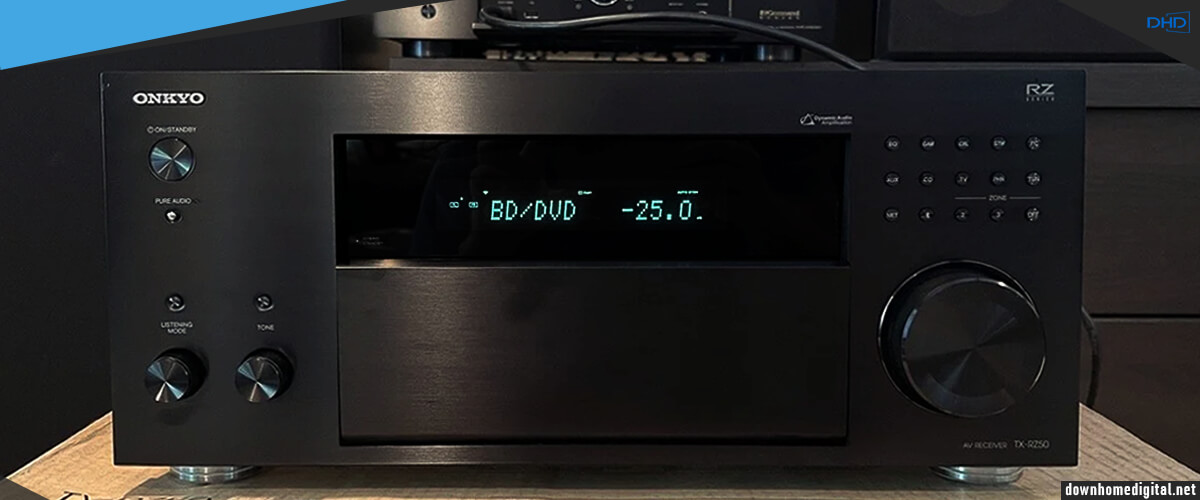
I like Onkyo a little less in music than other brands, but I was still impressed with the brand’s work in streaming services. I love classical rock and jazz and enjoy listening to live recordings of The Beatles, even raw ones. You can hear quite a bit while maintaining the authenticity of the recordings.
On the Onkyo TX-RZ50 website, you can see this “Klipsch Optimize Mode” label, under which you can read that the companies have teamed up to create an optimal combination and achieve an enhanced sound that is as true to the author’s original intent as possible. And I can safely recommend using a pair of floorstanding speakers from the Reference Klipsch R-820F lineup with this receiver. It’s a perfect combination of impedance and power, and I like the sturdy wire connectors. The sound is awesome, especially if you listen to high-quality audio.
The Onkyo TX-RZ50 is the best Onkyo AV receiver with 9 channels of amplification and the option to have 11 channels in the future, being the 2nd in the brand’s overall lineup. With it, you have access to the latest video formats (all HDMI ports support 8K video), the most popular surround sound formats, and advanced wireless connectivity options for better audio quality. Whether you love movies, stereo, or gaming consoles, being a multi-zone receiver can provide you with all these features at the same time. What more could you want for a reasonable price, considering that the Onkyo and Klipsch collaboration has even ensured the perfect compatibility between the receiver and the speaker system?
| Power |
|
| HDMI features |
|
| Video features |
|
| Network |
|
| Surround sound processing |
|
Pros
- The 9-channel receiver can be expanded to an 11-channel system.
- The largest power rating is 120 watts, with a good 0.08% distortion rating.
- All 7/2 HDMI ports are version 2.1.
- 3-zone audio and video transmission for 2 zones.
- Advanced wireless streaming capabilities at a high level.
- The Onkyo Control App is free and suitable for Android or Apple.
- THX Certified Select means a high sound rating.
- Perfect match with Klipsch speakers, guaranteed by the manufacturers’ collaboration.
Cons
- Small and awkward control buttons.
- Sonos and voice assistants are only available with special devices you must buy separately.
Onkyo TX-SR494 – budget
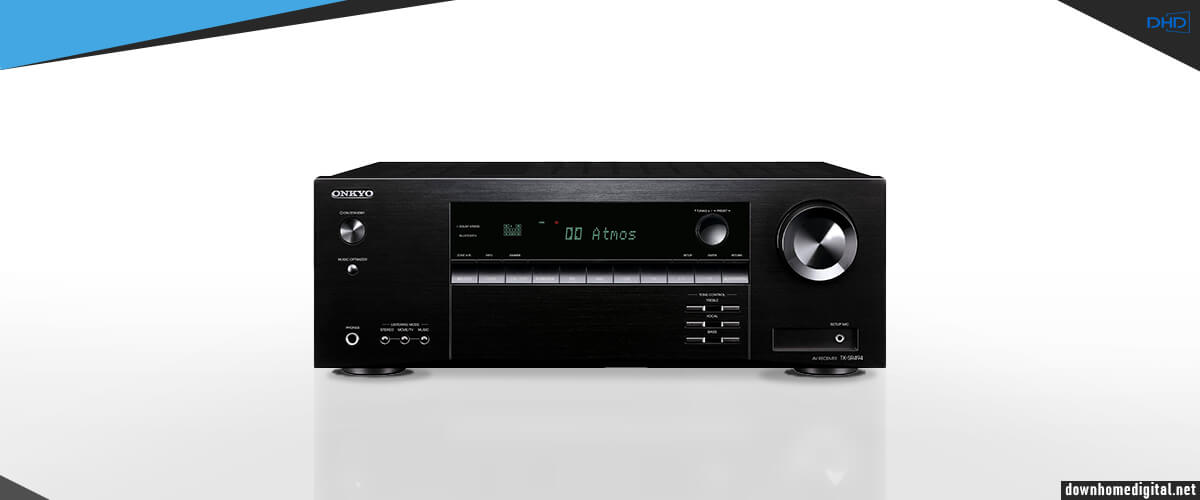
The next receiver I suggest you consider is the Onkyo TX-SR494. This device is the most inexpensive one in my rating, and it is a 7.2-channel device with 80 W power (8 ohms, 20 Hz – 20 kHz, 2 ch). This is the lowest wattage of all the Onkyo 7-channel receivers in my chart.
Describing the look and feel of Onkyo receivers is not difficult at all. They are very similar to each other, and I like the fact that the brand does not abandon large, well-viewed LCDs in favor of fashion. Essentially, it’s such a regular standard receiver without any major differences. The main drawback that screams of the budget model is the frequency control with buttons. That is, I did not get the desired settings, but only the ones offered to me by TX-SR494. While using the remote control, I found that some buttons did not correspond to the name. To be honest, this is the first time I’ve seen this.
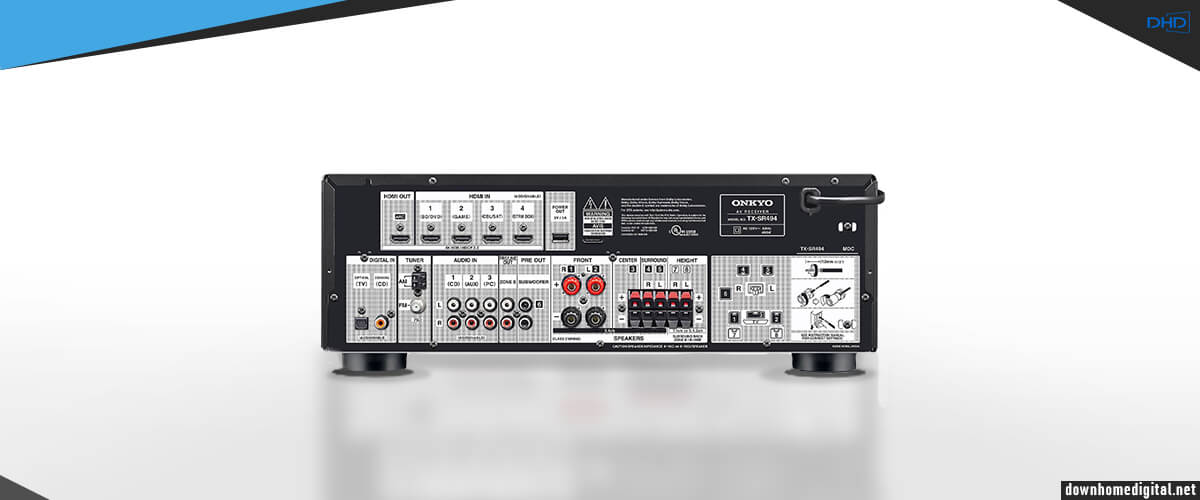
The TX-SR494 is going to dramatically improve your TV with an impressive sound. Seven channels of high current gain give you the freedom to choose your speaker configuration. I noticed that the receiver doesn’t have any prominent features at high or low frequencies. The sound was flat, with no dynamic range. The vocals were muted. But with Dolby Atmos Height Virtualizer and DTS Virtual: X technologies, you can achieve quite decent sound. I was impressed (for such a simple receiver) with the Vocal Enhancer feature, which improved the audibility of dialog.
However I want to emphasize that the technical equipment of this receiver contributes to obtaining pretty nice stereo sound. The device receives the signal via a multi-channel AKM-DAC with a resolution of 32 bit/384 kHz. The custom DAC design allows the TX-SR494 to be much more interesting to buy than similar receivers such as the Denon AVR-X1600H. That’s why I picked the receiver as the best budget AVR for home theater.

However I want to emphasize that the technical equipment of this receiver contributes to obtaining pretty nice stereo sound. The device receives the signal via a multi-channel AKM-DAC with a resolution of 32 bit/384 kHz. The custom DAC design allows the TX-SR494 to be much more interesting to buy than similar receivers such as the Denon AVR-X1600H. That’s why I picked the receiver as the best budget AVR for home theater.
Despite being a budget unit, it has AccuEQ auto-calibration with EQ for subwoofer and AccuReflex for 5.2.2-channel systems with Dolby Atmos support. But in reality, it’s just a calibration mic, and you can tune the system to the usual normal, non-annoying sound. I tweaked the frequencies to my liking with the buttons afterward (well, as much as possible), and the sound was basically fine. Let’s say I didn’t hear a mess; everything is quite decent for such money.
You can’t really call the Onkyo TX-SR494 a wonderful value. But I honestly consider the receiver in the specified category of budget models, and I can confidently say that it is better than many models of other brands at an identical price. The characteristics of the model correspond to the category. It broadcasts video in 4K resolution, has 7 channels of amplification, not bad power for a small room, Bluetooth, and built-in Pandora service. And I honestly think that this is quite enough if you don’t want to spend on buying a home theater. However, in my selection, there are 7-channel receivers that are slightly more expensive but have more advanced features.
| Power |
|
| HDMI features |
|
| Video features |
|
| Network |
|
| Surround sound processing |
|
Pros
- Vocal Enhancer improves dialogue audibility.
- The AKM-DAC with 32-bit/384kHz resolution sets the receiver apart from identically priced models.
Cons
- Lowest power among 7-channel receivers in the rating.
- The smallest number of HDMI ports in the selection.
- Does not work with 8K content.
- The only receiver of the selection without Wi-Fi.
- Bluetooth audio is a bit lacking in sound quality.
- Using the remote control is inconvenient because of the inaccurate name of the buttons on it.
Onkyo TX-NR6100 – also a great choice

Meet another decent entry – an Onkyo TX-NR6100 receiver that would be a great enhancement to your home theater system. It is also like TX-SR494 – AVR with 7 channels of amplification, but in terms of its functionality, it is closer to the leader of the Onkyo TX-RZ50 selection. Its price is in the budget segment, so TX-NR6100 can be a good choice for those who want to save money but with fewer compromises.
Externally, the model in question is no different from the TX-SR494. And you also can’t tune frequencies more sensitively than the button variation on the front panel offers you. In this case, the remote control turned out to be more accurate, but it does not inspire confidence at all and seems flimsy.
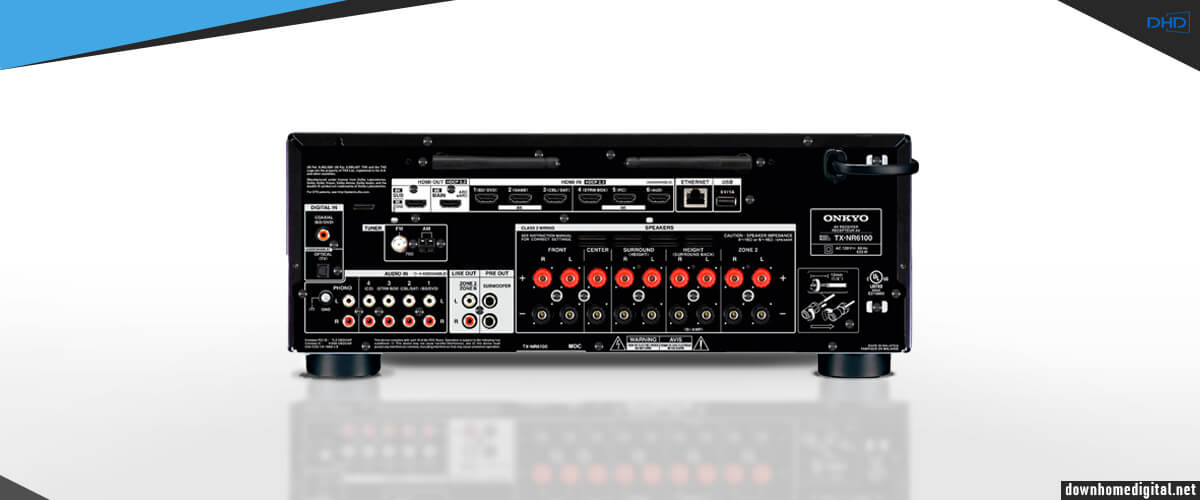
Being a 7.2 channel receiver, this device will ensure an enhanced gaming experience, rich sound as you listen to music, and high-quality video playback. Similar to TX-NR7100, this device is suitable for 4K and 8K videos and games. There are advantages in this area over the TX-SR494, which does not support 8K at all.
The auto low latency mode and quick frame transport feature will provide you with a lag-free watching or listening experience and optimize the latency from source to screen. You will also enjoy Dolby Atmos and DTS:X, as you can attach your height-enabled surround system for a 3-D soundscape composition. Nothing supernatural, but the sound is pretty dense. The 100 watts of power is enough to fill a room of about 200 square feet to hear clear sound from every corner. Testing the receiver in my other studio room, a slightly larger one, I found that the sound became a bit diffuse, and while I could hear quite a bit of detail, I couldn’t hear any more brightness. I found the TX-NR6100 to sound more interesting and colorful than the TX-SR494. I had enough bass for a budget device, and the upper frequencies were quite balanced, not giving out unnecessary squeals. But the equalizer setting can cause a slight bewilderment. You have to adjust it for each speaker without hearing how the sound changes when you adjust it.
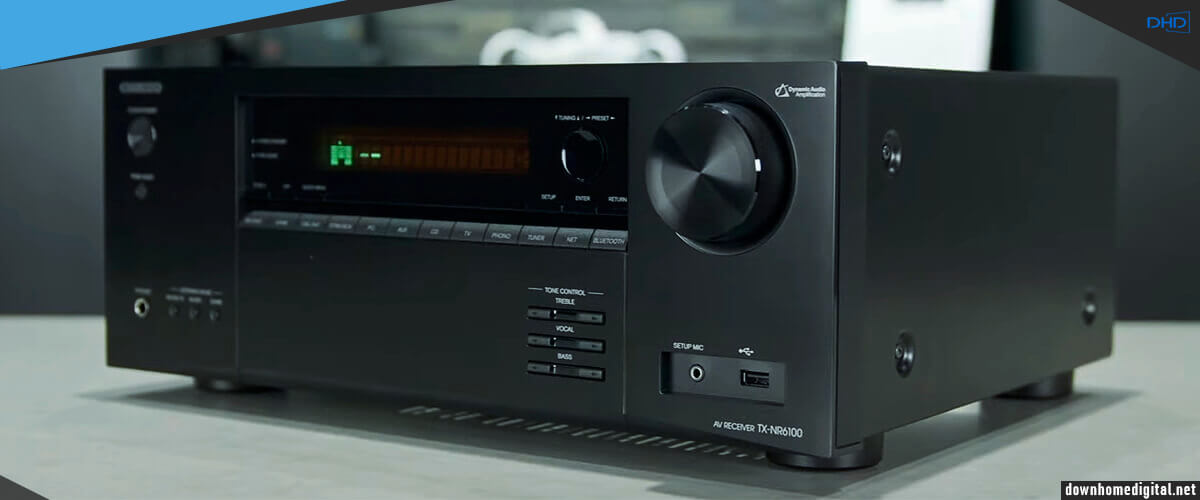
This model has more streaming services and Wi-Fi built-in, so it would suit those who want a multi-faceted system that can utilize modern resources. I liked the way the stereo sounded. Again, it is nothing special, but it is a decent and pretty clear sound to call it. I often encounter too thick bass or scattered midrange in other models at an identical price. Everything sounds quite even here, without overloading to one side or the other. But I’m not talking about the audiophile level.
Onkyo TX-NR6100 – will be a good choice among Onkyo receivers if you want to get something between the selection leader TX-RZ50 and budget TX-SR494. I think it’s a sensible choice, as it’s second only to the leader in terms of channel count and power, and it’s even THX Certified for sound quality, but its superiority over the most budget-friendly receiver on the chart is pretty obvious.
It combines qualities sufficient for a full-fledged home theater system with Dolby Atmos, 8K picture, built-in streaming services for a better listening experience, and very good sound for its price category, especially well-balanced in a small room.
| Power |
|
| HDMI features |
|
| Video features |
|
| Network |
|
| Surround sound processing |
|
Pros
- Unlike TX-SR494, 3 HDMI inputs support 8K video.
- Balanced and quite bright sound in a small room (up to 200 square meters).
- More streaming services and Wi-Fi are built-in, unlike the more budget TX-SR494.
- The sound in surround formats for movies is more colorful than the TX-SR494.
Cons
- Flimsy remote control.
- Inferior to the leader of the selection TX-RZ50 in the number of channels and power.
- The equalizer setting of the speakers is perplexing.
Onkyo TX-NR7100

Onkyo TX-NR7100 is a decent alternative to the leader of my rating, Onkyo TX-RZ50. It’s also a 9-channel receiver, but without the possibility of system expansion and with less power of 100 W (8 Ohms, 20 Hz-20 kHz, 0.08% THD, 2 ch). And, of course, its price is a bit lower than that of AVR, which occupies the first position of the selection.
At first glance, the receivers look almost no different externally, but the TX-NR7100 doesn’t have the controls hidden under the cover. While pressing the buttons under the wonderful big LCD, I pawed half of the glass, and I don’t like it. But a lot of receivers have this “problem”. The feet are plastic, not metal like the TX-RZ50, but overall, the receiver is quite heavy and gives a nice impression of reliability.
This 9.2 channel THX certified AV receiver would ensure you enjoy the immersive theater-like sound from the comfort of your home. The massive power transformer, 10,000 uF storage capacitors, and aluminum heat sinks indicate that his amplifier can deliver high currents, allowing surround sound to achieve true spatiality and maximum localization accuracy.

Almost all the features of Onkyo TX-NR7100 are similar to TX-RZ50, so I’ll try to tell you about those that didn’t make it into the description of the rating leader. The receiver is equipped with decoders for all popular surround sound formats, including Dolby Atmos and DTS:X. This model can be used to build 3D Systems in configurations up to 5.2.4 without external amplifiers. You can also create a virtual surround sound system using Dolby Atmos Height Virtualizer. In addition, this model has IMAX content processing technology.
The AV receiver has seven HDMI inputs and two outputs that support 4K video with Dolby Vision and HDR10 technology. A 1080p signal input to these inputs can be converted to 4K resolution. HDMI inputs 1 to 3 and Main / Sub outputs support 8K / 60p (4: 2: 0/10-bit). The AV receiver features a 32-bit / 384 kHz DAC that provides precise signal processing. For additional elimination of distortion of low-level signal in the AV receiver, there is proprietary VLSC technology.
The networking features in the Onkyo TX-NR7100 are based on a next-generation SoC module remote from the audio circuitry to eliminate cross-talk distortion. In addition, the AV receiver supports DTS Play-Fi, Chromecast, and FlareConnect technologies, allowing it to be used as part of appropriate multi-room systems. Network connectivity is possible via Ethernet or Wi-Fi, and the Onkyo TX-NR7100 can play audio files with 24-bit / 192 kHz (PCM) and DTS 11.2 MHz parameters. For integration into externally controlled systems, the AV receiver has RS-232 and Ethernet interfaces, as well as a control trigger and a jack for an external IR sensor.

As for the sound, I was not impressed by its powerful bass or incredibly fast dynamics, but the audio is characterized by high resolution – without the slightest hint of graininess. It is not inferior to the Onkyo TX-RZ50 in the overall sound picture so that I won’t describe it unnecessarily. The trade-offs due to the lower price are related to other aspects. Here, we can talk about the DIRAC live calibration system, which both receivers have and which, in my opinion, is very complicated if you have never set up a system. But it is worth it. Anyway, you may not get a signal on your TV if you don’t set up your system properly, so I’d go to a professional or prepare to spend hours learning the settings.
Onkyo TX-NR7100 is incredibly similar to the leader of the selection, Onkyo TX-RZ50, and it could well take the first place if it were not inferior to the latter in the number of channels (there is no possibility of expanding the system to 11-channel) and power. But overall, it’s just as decent a device with all the advantages of modern features for receivers: 8K video (though only on 3 HDMI ports, not all of them like the TX-RZ50), built-in streaming services, the most popular full and virtual surround sound formats, and high-quality DACs.
If asked, I’d rather pay a couple hundred dollars extra and have a full-fledged winner than a simplified version of it.
| Power |
|
| HDMI features |
|
| Video features |
|
| Network |
|
| Surround sound processing |
|
Pros
- Generally similar in functionality to the leader of the selection Onkyo TX-RZ50.
Cons
- Less power than the rating leader.
- Only 3 HDMI inputs support 8K video.
- DIRAC live technology is very complex and will require effort and time.
- If you don’t set up the receiver carefully, it won’t transmit the signal to your TV.
Onkyo TX-NR696
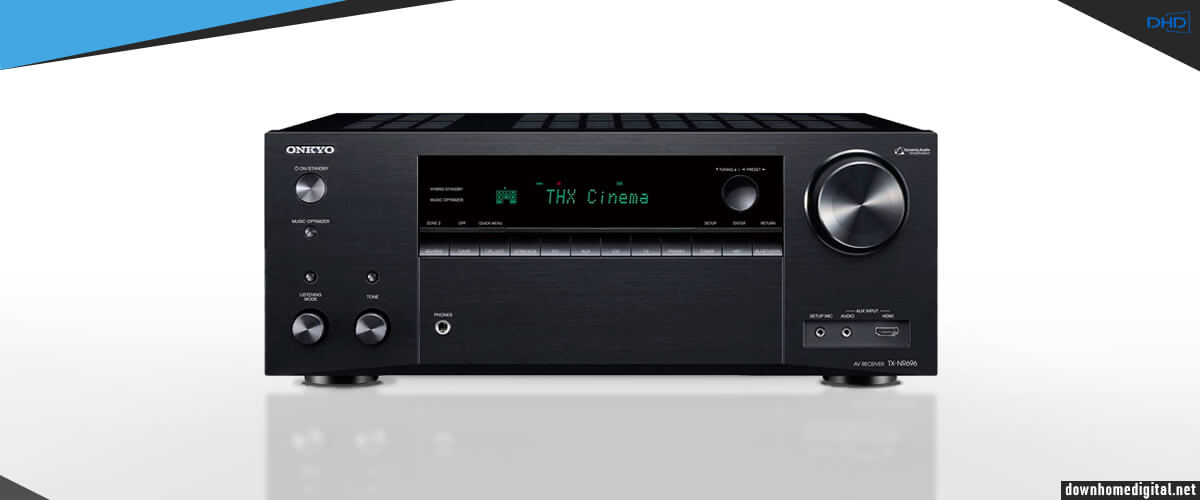
Back to the topic of 7-channel receivers, I suggest you take a look at the TX-NR696. This model was released in 2029, so it’s a bit outdated relative to the TX-NR6100, but its nicer price may interest you because the receiver also has THX Certified Select certification. The Onkyo TX-NR696 features powerful amplification capable of delivering up to 210 W per channel at 6 Ohm or 100W at 8 Ohm. I think it is pretty ideal for building a 7.2 channel or Dolby Atmos 5.2.2 home theater system.
I will share with you why I came to this idea. First of all, the TX-NR696 is compatible with the latest multi-channel audio streams, including Dolby Atmos and DTS: X. Moreover, thanks to the powerful DSP modes, the Onkyo TX-NR696 amplifier can simulate a reproduction on seven speakers from a 5.1-channel configuration.
I describe my feelings about the look and construction of Onkyo receivers in every review, but it gets harder to do so each time. They all look alike, just like one another. Except that, in this model, it was more convenient for me to test the receiver because there is an HDMI port on the front panel. More expensive models usually place a simple port here that doesn’t have a 2.1 version, but the TX-NR696 has simple ports as it is. All in all, I don’t know how often you’ll need it, but I was comfortable with it. Otherwise, the case has the same pros and cons as the other models.
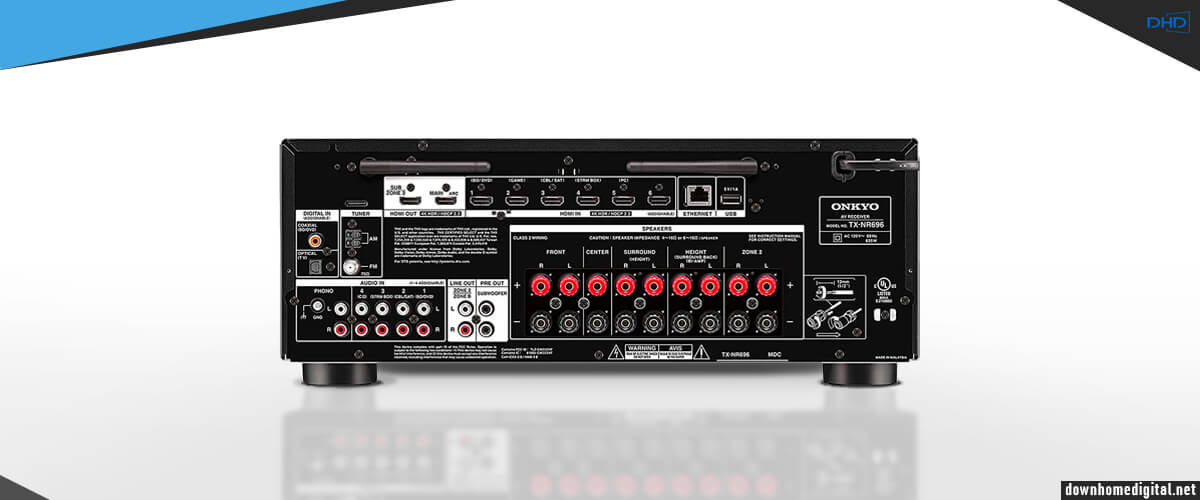
The video processing of this model is simpler than that of TX-NR6100, and this is due to the year of release. Here, we only have video processing in 4K. And it is still well-suited for gamers. It’s also a SMART AVR that has some streaming services and Chromecast built-in; it’s compatible with Google Assistant (provided you have a smart speaker) and works with Airplay 2. But, of course, you should expect some compromises. Two obvious facts came to light during testing. Firstly, when transmitting sound via Bluetooth, the connection breaks, or the sound is transmitted jerkily. And if the TV is connected to the receiver via HDMI ARC port, I often observe the desynchronization of sound and image.
Honestly, I advise you to pay attention to it if you want something versatile that is just as comfortable with music as it is with watching movies or streaming videos. The sound of the Onkyo TX-NR696 is pleasant in all of these situations.
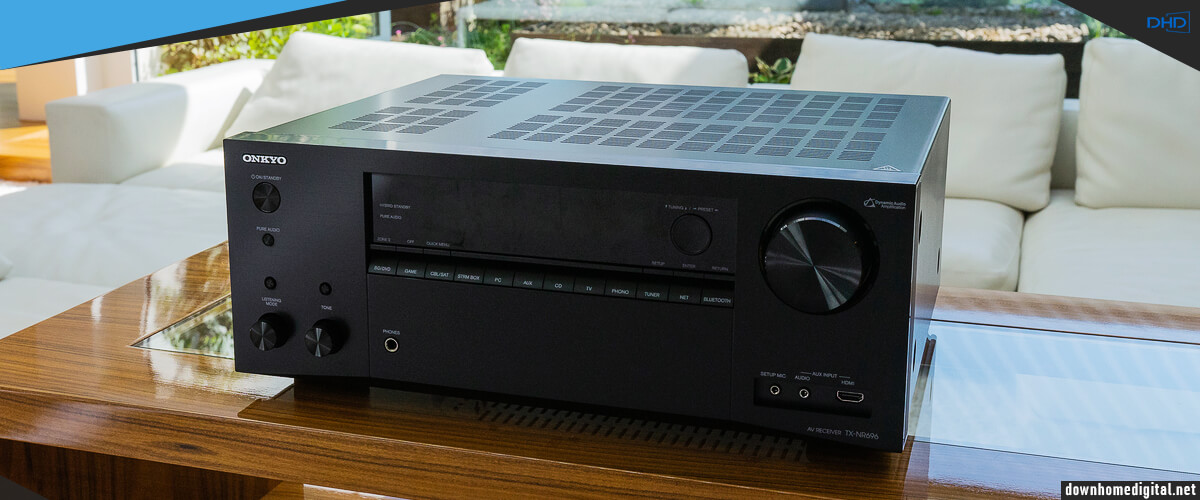
I compared it to a similarly priced rival, the Denon AVRS740, and found it to be the nicer of the two. The Onkyo TX-NR696 has a very balanced sound stage, and the processing of movie sound effects is quite dynamic. You won’t miss a single explosion or chase. Surprisingly good for a budget receiver.
This model is inferior to the more expensive TX-NR6100 only because it does not know about the existence of 8K video. Given the not-so-wide content in this resolution today, I can’t say that this is a catastrophic disadvantage for an inexpensive receiver. I can say that Onkyo TX-NR696 can be suitable for a wide audience of users. And at this price, no other device compares to it in terms of flexibility in connecting sources of your choice and sound level. It offers a balanced Dolby Atmos performance if you’re a movie fanatic. It’s also a decent option to listen to music in stereo or streaming.
Yes, of course, the quality of the streaming signal is directly related to the cost of the receiver, and there are drawbacks to using HDMI ARC or Bluetooth. If you are unsatisfied with its faults, I advise paying a couple hundred bucks extra and buying a more reliable and modern TX-NR6100.
| Power |
|
| HDMI features |
|
| Video features |
|
| Network |
|
| Surround sound processing |
|
Pros
- The receiver has full support for Google products, including Chromecast and Google Assistant.
- The Onkyo TX-NR696 supports all the latest codes as well as THX certification.
Cons
- Supports 4K video only.
- When transmitting sound through Bluetooth, there are connection breaks, or the sound is transmitted in jerks.
- If the TV is connected to the receiver via the HDMI ARC port, sound and picture desynchronization is possible.
Discontinued models
Often in my reviews, you can find such a section where I consider discontinued models, which nevertheless quite meet the requirements of the average user, and the greatest part is that they can still be bought at a reduced price. Onkyo has a wide range of more or less similar models and often releases new products with improvements. But is it worth overpaying for them? Check out the 2019 models and decide. And I believe that they are worthy of our attention.
Onkyo TX-NR797
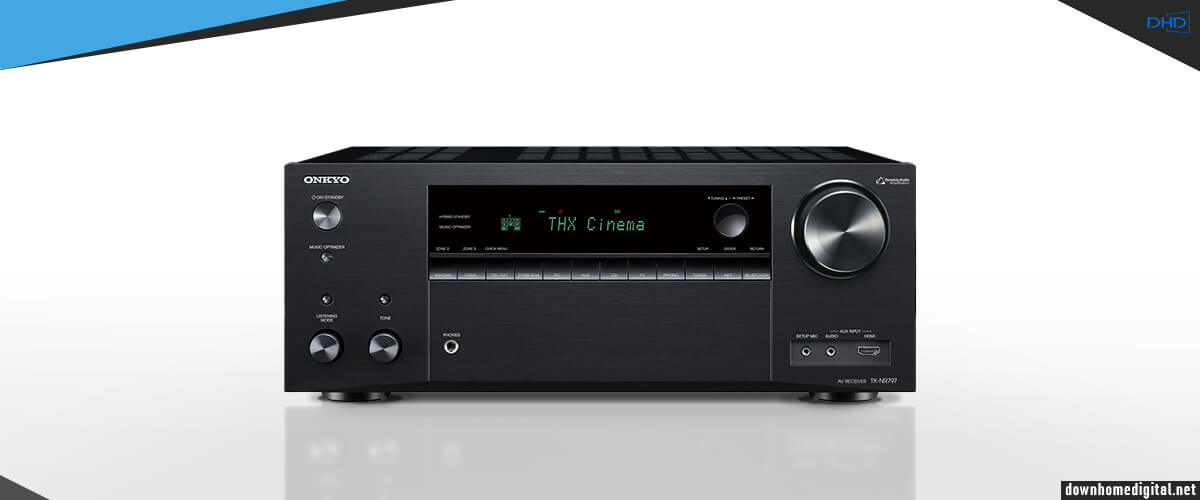
I will continue the review with a model that can rightfully be considered one of the best Onkyo receivers presented here. It has a 9-channel amplifier and delivers 100 W and stable performance with a load of 8 Ohm or 220 W at 6 Ohm. Reminds you of the Onkyo TX-NR7100, doesn’t it? Yes, the TX-NR797 was replaced by it. Let’s understand whether it is worth overpaying for a novelty released in 2021.
Needless to say, the receivers I’m comparing are as similar as twins. You literally can’t tell one from the other, except for the model name. Moreover, our aging friend has a DAC reproducing 384 kHz/32-bit audio, which is better than the TX-NR7100. And it is thanks to this that I managed to get the sound to be at the same level as in the cinema.
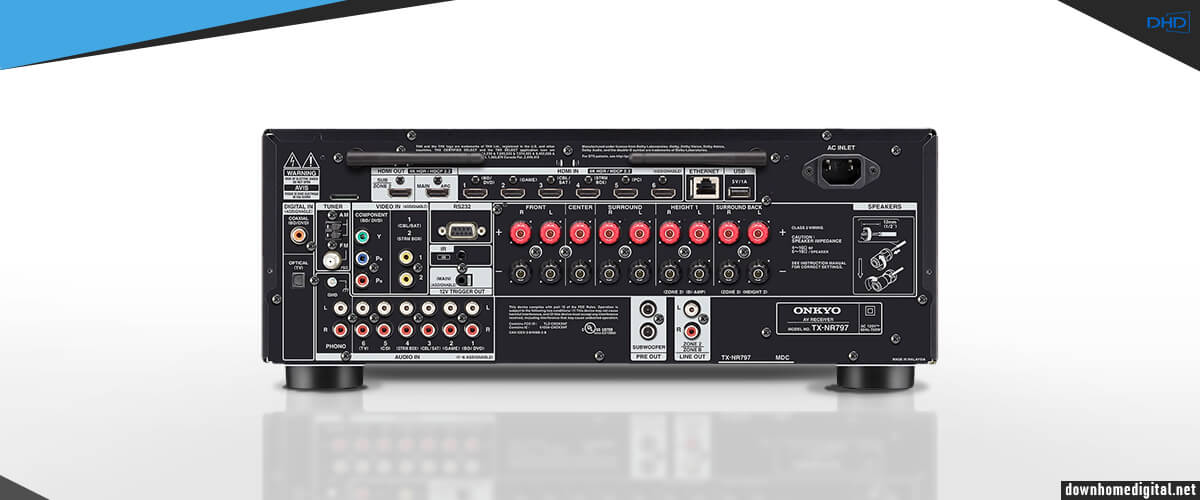
However, without accurate calibration, I would hardly get a decent sound. The NR797 features Onkyo’s AccuEQ Advance room calibration system that measures sound in 9 positions. However, the TX-NR7100 is more advanced at this point, as it owns the Dirac Live room correction system, which is far ahead of the standard system. However, my instruments have shown that there are problems with the firmware. They sometimes cause sound to be lost for short periods of time. As far as I am familiar with inexpensive receivers, this is a fairly common problem; I could well call it acceptable or tolerable within the price category. And if everything is evident with the sound quality in the main hall, there is one fact that will pleasantly surprise you. Sonos technology feature allows us to connect to Sonos speakers and provide sound to additional rooms. Bluetooth only supports SBC codec (TX-NR7100 has a more advanced version with support for AAC, aptX, and aptX HD). But it has a built-in Chromecast, AirPlay 2, and DTS Play-Fi. But unlike its replacement, our receiver doesn’t work with voice assistants.
I was also quite satisfied with the video capabilities of the model, but they are inferior to the TX-NR7100. There is full support for 4K / 60 FPS video signals. However, remarkably, the upscaling of a regular 1080p signal to 4K works well.
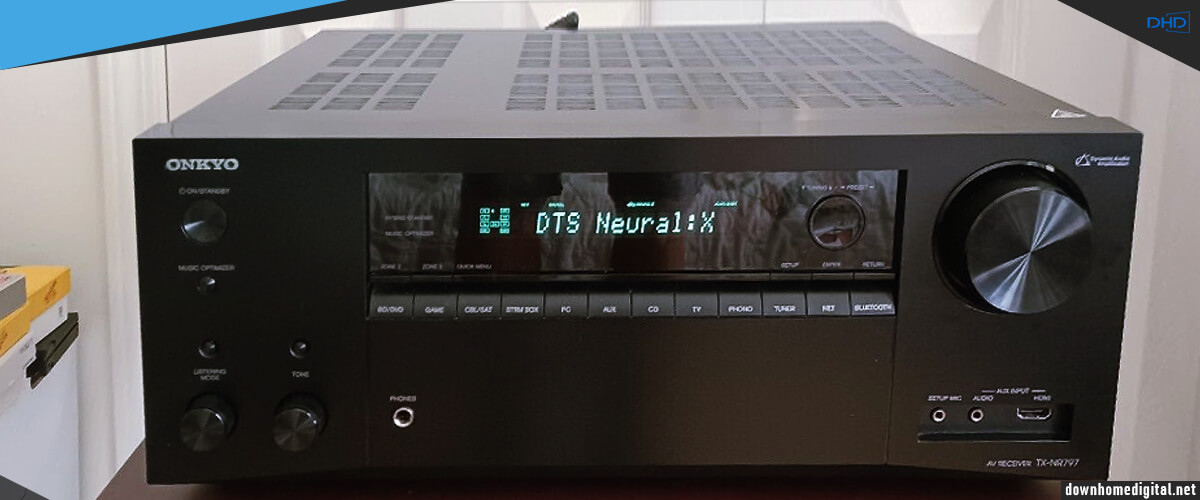
For the sake of completeness, I want to draw your attention to the surround sound of this receiver. Here, you can find a complete set of Dolby Atmos and DTS: X decoders. It’s important to note that I usually explore Dolby Atmos Height Virtualizer for smaller systems. But in the case of the TX-NR797, the upper channel simulation sound surprised me. And if you’re looking for a multi-channel receiver for multiple rooms but want Dolby Atmos in the main, it’s well up to the task. I enjoyed brisk, bright (rare for Onkyo) movie playback; in this case, I stand by the high THX Certified Select rating.
Fairly powerful receiver to get a rich, realistic, and breathtaking sound. I was happy that the device could be connected easily to other pieces of my equipment and supply sound zones.
To Onkyo TX-NR797, you can apply the definition of “old but lucky”. Yes, being released in 2019, it can’t compete with modern devices in video (it only supports 4K), it doesn’t work with voice assistants, and it has a weak room calibration system. But it’s discounted right now, so we have nothing to complain about.
In 2021, Onkyo released a more modern model, TX-NR7100, practically a twin brother but with fancy improvements. I’m not insisting on anything, but with the same number of channels and power, unless you are sensitive to sound at the level of nuance (in normal conditions, the user will not find a difference), I would choose the novelty. Nevertheless, TX-NR797 will be a decent choice if you decide to save money.
| Power |
|
| HDMI features |
|
| Video features |
|
| Network |
|
| Surround sound processing |
|
Pros
- The DAC handles 384 kHz/32 Bit audio, which is better than the more expensive TX-NR7100.
- The TX-SR494 delivers the highest current in its class thanks to a custom high output transformer and discrete amplifiers inside.
Cons
- AccuEQ Advance calibration system is significantly inferior to Dirac Live.
- Does not have 8K video processing.
- The firmware has problems due to which the sound sometimes disappears.
- Doesn’t work with voice assistants.
Onkyo TX-RZ840
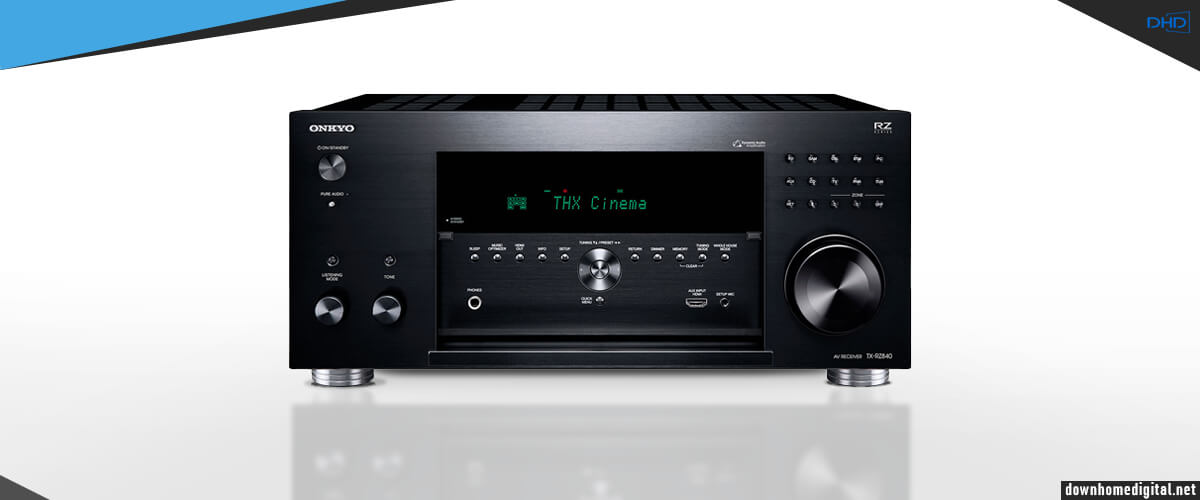
I want to finish my review with a rather interesting model, the Onkyo TX-RZ840, as it is a cheaper alternative to the leader of the selection, the Onkyo TX-RZ50. In fact, it is absolutely identical in appearance, a 9-channel receiver with the ability to expand to a system with 11 channels of amplification, but at a lower price.
The TX-RZ840 impressed me with its sizable 8-inch height. As in the TX-RZ50, the facade remains rather minimalistic; there is a screen and a small number of buttons and control knobs. Otherwise, it is made of good black metal. However, the remote control is made of low-quality plastic and is not very comfortable, but this is a constant problem with Onkyo in older models. The controls work very smoothly, and the buttons are unusually small and make me feel awful, even though I don’t have very thick fingers. All in all, it’s just as I described earlier. Once again, though, I must say that the solidity of the design is undeniable.
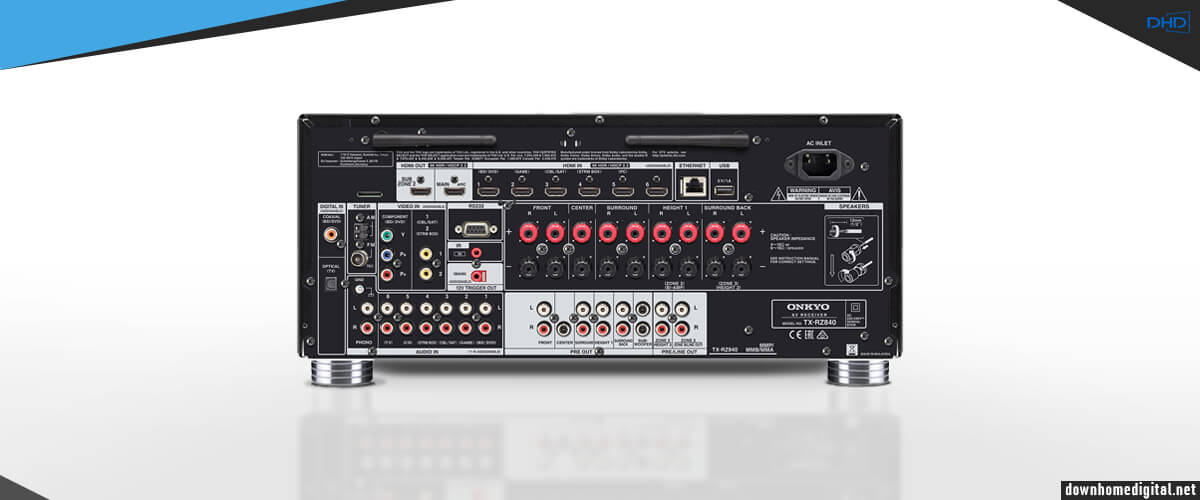
Let’s take a look at the rear panel of this receiver. There are seven HDMI inputs, including one hidden behind the hatch. They are all 4K, HDR, and HDCP 2.2. Everything is just like the new Onkyo TX-RZ50, but without the 2.1 version, so you won’t get 8K video. This is one of the reasons why Onkyo decided to re-release the popular model with a minimum of changes. Also, you can see seven analog audio inputs, including one for a vinyl turntable.
If everything is obvious with the appearance, you only have to get acquainted with the device’s capabilities. The power rating of this receiver is not bad for this level. It can handle a rated power of 120W at 8ohm, which is also identical to the replacement model.
The first thing I did in the test was to run several Blue-Ray film clips in order to familiarize ourselves with the sound signature of this RZ840. And it immediately became clear that this amplifier should not be classified in the category of ultra-dynamic devices. It works great in the mids but weak in the high and low sound ranges.
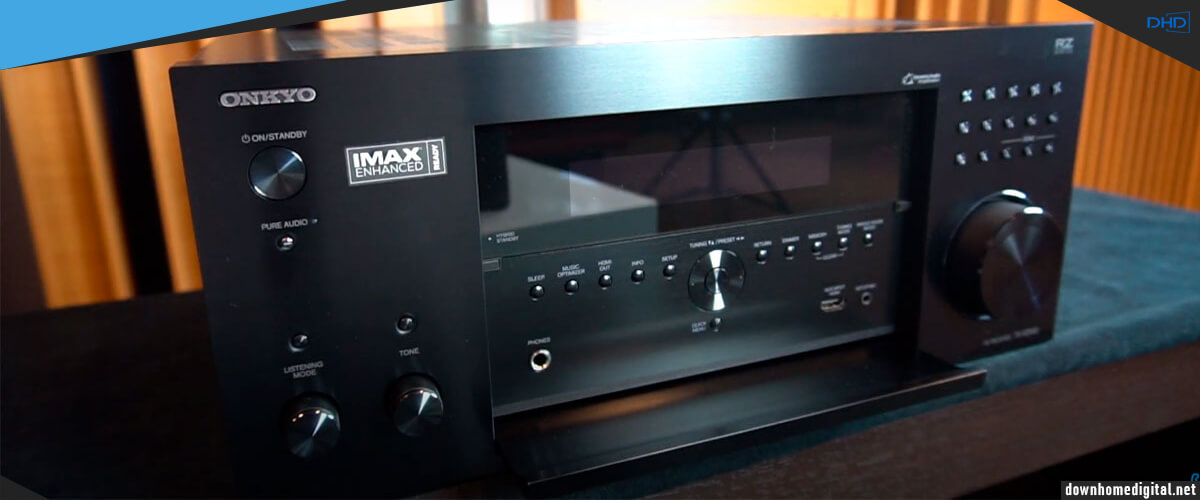
However, something impressed me, and that was the receiver’s ability to create surround sound throughout the room. The fronts are ideally linked to the side channels as to the ceiling speakers. When listening, you will not feel the breaks during the “movement” of the sound; everything is natural. The RZ840 masters its subject without any exuberance, an excellent example of quite good design. The subwoofer channel integrates well with the sound to provide all the necessary dynamics. The difference in the availability of the calibration system should also be noted here. As in the previous case, the older TX-RZ840 is equipped with the not the most attractive, but at least advanced, more detailed AccuEQ Advance with AccuReflex, while the TX-RZ50 that replaced it is equipped with Dirac Live (and AccuEQ Room Corrections), which is much more nuanced but difficult to control.
In stereo, the receiver also showed itself from the bright side. In general, the manufacturer did not go too far here and left almost everything in TX-RZ50 as in TX-RZ840. However, among the disadvantages of the model we are considering and the differences from Onkyo TX-RZ50, we can note the lack of support for voice assistants and Bluetooth, which works only with SBC and AAC codec (does not support aptX HD codec).
The Onkyo TX-RZ840 is a great alternative to the leader of my selection for those who want to scrimp against all my beliefs. It has many of the advantages of the TX-RZ50: it has 9 channels of amplification and can be expanded to an 11-channel system; it sounds great; they even look absolutely identical. But in this case, you get an outdated device with somewhat backward features: it doesn’t support 4K video, it doesn’t work with voice assistants, its calibration system is much more simplistic, and its Bluetooth doesn’t support the aptX HD codec.
I advise you to study the product specs carefully. If you’re ready to spend a little more money to avoid upgrading your home theater for a long time, I recommend the more advanced Onkyo TX-RZ50.
| Power |
|
| HDMI features |
|
| Video features |
|
| Network |
|
| Surround sound processing |
|
Pros
- Like the Onkyo TX-RZ50, it can be expanded to an 11-channel system.
- It sounds great, dynamic, and smooth.
Cons
- The remote control is made of inferior plastic and is not very comfortable.
- Does not have HDMI 2.1 and only works with 4K video.
- The AccuEQ Advance with AccuReflex calibration system on the TX-RZ840 is far inferior to the Dirac Live on the TX-RZ50.
- The amplifier is excellent in the midrange but weak in the treble and bass.
- Does not work with voice assistants.
- Bluetooth does not support an aptX HD codec.






